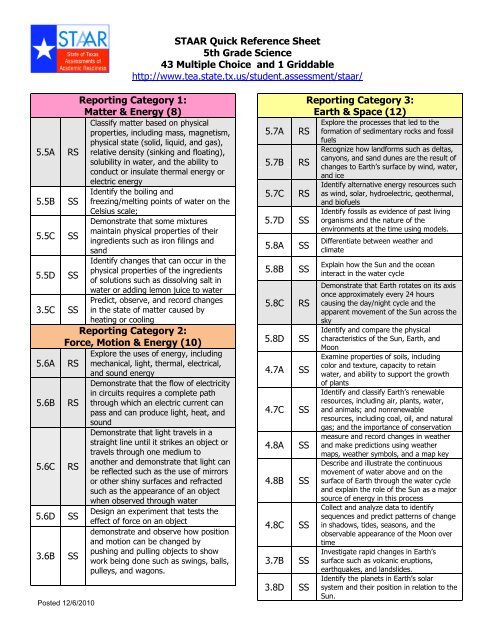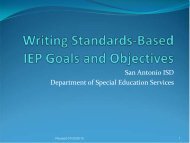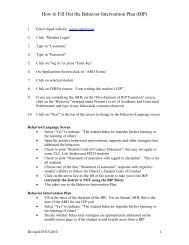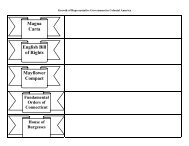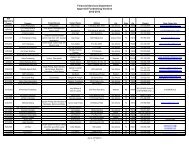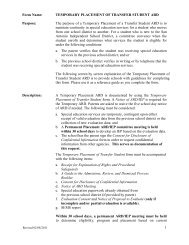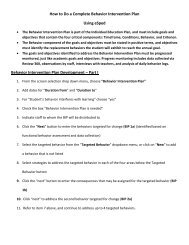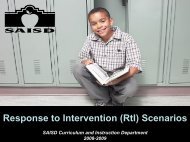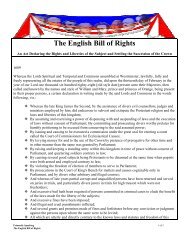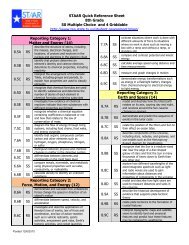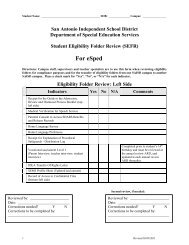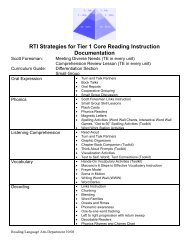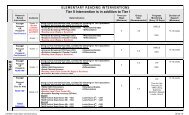5th grade STAAR Science
5th grade STAAR Science
5th grade STAAR Science
You also want an ePaper? Increase the reach of your titles
YUMPU automatically turns print PDFs into web optimized ePapers that Google loves.
<strong>STAAR</strong> Quick Reference Sheet<br />
<strong>5th</strong> Grade <strong>Science</strong><br />
43 Multiple Choice and 1 Griddable<br />
http://www.tea.state.tx.us/student.assessment/staar/<br />
Reporting Category 1:<br />
Matter & Energy (8)<br />
Classify matter based on physical<br />
properties, including mass, magnetism,<br />
physical state (solid, liquid, and gas),<br />
5.5A RS relative density (sinking and floating),<br />
solubility in water, and the ability to<br />
conduct or insulate thermal energy or<br />
electric energy<br />
5.5B SS<br />
Identify the boiling and<br />
freezing/melting points of water on the<br />
Celsius scale;<br />
5.5C SS<br />
Demonstrate that some mixtures<br />
maintain physical properties of their<br />
ingredients such as iron filings and<br />
sand<br />
Identify changes that can occur in the<br />
physical properties of the ingredients<br />
5.5D SS<br />
of solutions such as dissolving salt in<br />
water or adding lemon juice to water<br />
Predict, observe, and record changes<br />
3.5C SS in the state of matter caused by<br />
heating or cooling<br />
Reporting Category 2:<br />
Force, Motion & Energy (10)<br />
Explore the uses of energy, including<br />
5.6A RS mechanical, light, thermal, electrical,<br />
and sound energy<br />
5.6B RS<br />
Demonstrate that the flow of electricity<br />
in circuits requires a complete path<br />
through which an electric current can<br />
pass and can produce light, heat, and<br />
sound<br />
Demonstrate that light travels in a<br />
straight line until it strikes an object or<br />
travels through one medium to<br />
another and demonstrate that light can<br />
5.6C RS<br />
be reflected such as the use of mirrors<br />
or other shiny surfaces and refracted<br />
such as the appearance of an object<br />
when observed through water<br />
5.6D SS<br />
Design an experiment that tests the<br />
effect of force on an object<br />
3.6B SS<br />
demonstrate and observe how position<br />
and motion can be changed by<br />
pushing and pulling objects to show<br />
work being done such as swings, balls,<br />
pulleys, and wagons.<br />
5.7A RS<br />
5.7B RS<br />
5.7C RS<br />
5.7D SS<br />
5.8A SS<br />
5.8B SS<br />
5.8C RS<br />
5.8D SS<br />
4.7A SS<br />
4.7C SS<br />
4.8A SS<br />
4.8B SS<br />
4.8C SS<br />
3.7B SS<br />
3.8D SS<br />
Reporting Category 3:<br />
Earth & Space (12)<br />
Explore the processes that led to the<br />
formation of sedimentary rocks and fossil<br />
fuels<br />
Recognize how landforms such as deltas,<br />
canyons, and sand dunes are the result of<br />
changes to Earth’s surface by wind, water,<br />
and ice<br />
Identify alternative energy resources such<br />
as wind, solar, hydroelectric, geothermal,<br />
and biofuels<br />
Identify fossils as evidence of past living<br />
organisms and the nature of the<br />
environments at the time using models.<br />
Differentiate between weather and<br />
climate<br />
Explain how the Sun and the ocean<br />
interact in the water cycle<br />
Demonstrate that Earth rotates on its axis<br />
once approximately every 24 hours<br />
causing the day/night cycle and the<br />
apparent movement of the Sun across the<br />
sky<br />
Identify and compare the physical<br />
characteristics of the Sun, Earth, and<br />
Moon<br />
Examine properties of soils, including<br />
color and texture, capacity to retain<br />
water, and ability to support the growth<br />
of plants<br />
Identify and classify Earth’s renewable<br />
resources, including air, plants, water,<br />
and animals; and nonrenewable<br />
resources, including coal, oil, and natural<br />
gas; and the importance of conservation<br />
measure and record changes in weather<br />
and make predictions using weather<br />
maps, weather symbols, and a map key<br />
Describe and illustrate the continuous<br />
movement of water above and on the<br />
surface of Earth through the water cycle<br />
and explain the role of the Sun as a major<br />
source of energy in this process<br />
Collect and analyze data to identify<br />
sequences and predict patterns of change<br />
in shadows, tides, seasons, and the<br />
observable appearance of the Moon over<br />
time<br />
Investigate rapid changes in Earth’s<br />
surface such as volcanic eruptions,<br />
earthquakes, and landslides.<br />
Identify the planets in Earth’s solar<br />
system and their position in relation to the<br />
Sun.
Reporting Category 4:<br />
Organisms & Environments (14)<br />
5.9A RS<br />
5.9B RS<br />
5.9C SS<br />
5.9D SS<br />
5.10A RS<br />
Observe the way organisms live and<br />
survive in their ecosystem by interacting<br />
with the living and non-living elements<br />
Describe how the flow of energy derived<br />
from the Sun, used by producers to create<br />
their own food, is transferred through a<br />
food chain and food web to consumers<br />
and decomposers<br />
Predict the effects of changes in<br />
ecosystems caused by living organisms,<br />
including humans, such as the<br />
overpopulation of grazers or the building<br />
of highways<br />
Identify the significance of the carbon<br />
dioxide-oxygen cycle to the survival of<br />
plants and animals<br />
Compare the structures and functions of<br />
different species that help them live and<br />
survive such as hooves on prairie animals<br />
or webbed feet in aquatic animals<br />
5.10B RS<br />
5.10C SS<br />
3.9A SS<br />
3.10C SS<br />
Differentiate between inherited traits of<br />
plants and animals such as spines on a<br />
cactus or shape of a beak and learned<br />
behaviors such as an animal learning<br />
tricks or a child riding a bicycle<br />
Describe the differences between<br />
complete and incomplete metamorphosis<br />
of insects<br />
Observe and describe the physical<br />
characteristics of environments and how<br />
they support populations and communities<br />
within an ecosystem<br />
Investigate and compare how animals and<br />
plants undergo a series of orderly changes<br />
in their diverse life cycles such as tomato<br />
plants, frogs, and lady bugs<br />
Scientific Investigation & Reasoning Skills<br />
These skills will not be listed under a separate recording category. Instead, they<br />
will be incorporated into at least 40% of the test questions in reporting<br />
categories 1-4 and will be identified along with content standards.<br />
Reporting Categories Number of Standards Number of Questions<br />
Readiness Standards Total Number of Standards 12 60%–65% 26-29<br />
Supporting Standards Total Number of Standards 22 35%–40% 15-18


